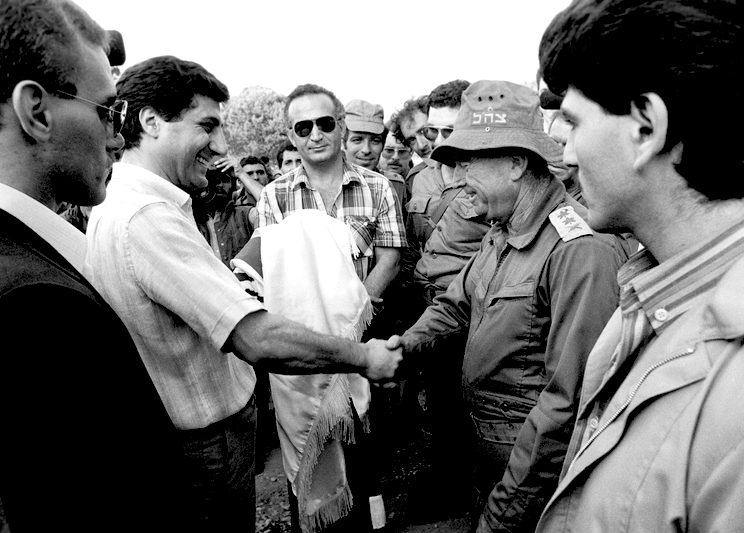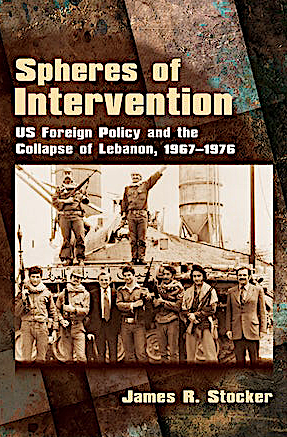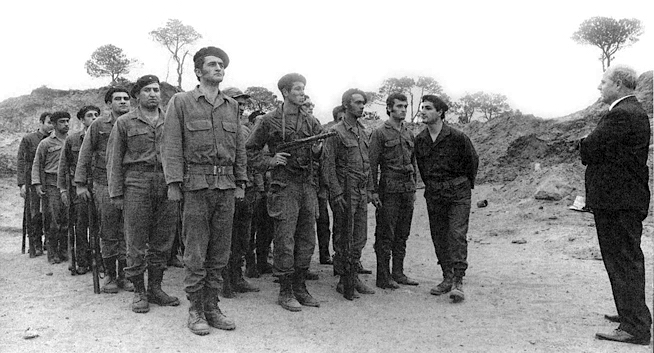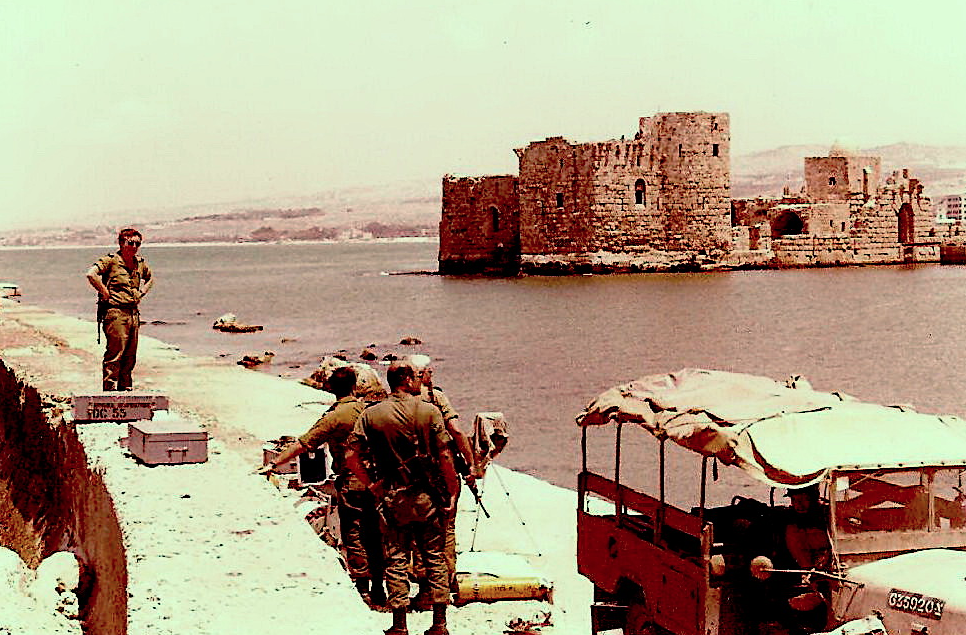THE ANGRY ARAB: Installing a War Criminal
When Israel invaded Lebanon in 1982, the imposition as president of Bashir Gemayyel — who introduced the worst savagery seen during the country’s civil war — was one of the chief goals, writes As`ad AbuKhalil.

Israel’s Chief of Staff Rafael Eitan (right) shakes hands with Bashir Gemayyel in Lebanon, June 1982. In center, in a checkered shirt is the representative of the Mossad, the intelligence agency. (IDF Spokesperson’s Unit, CC BY-SA 3.0, Wikimedia Commons)
By As`ad AbuKhalil
Special to Consortium News
 This year marks the 40th anniversary of Bashir Gemayyel’s installation by Israel as president of Lebanon and the 40th anniversary of his assassination.
This year marks the 40th anniversary of Bashir Gemayyel’s installation by Israel as president of Lebanon and the 40th anniversary of his assassination.
It was the summer of 1982. Israel had invaded Lebanon and controlled its state and picked out its next leader.
The U.S. was fully supportive of the move on behalf of the “war thug,” (which was how Richard P. Parker, former U.S ambassador to Lebanon, once told me that he and other Middle East experts at the U.S. State Department regarded Gemayyel).
Bob Woodward provides a description of Gemayyel’s close ties to Israel and to U.S. intelligence in his book Veil.
Not much is remembered about this period in the press, but a revisit of that era may shed light on how Israel and the U.S. intervene in countries and destroy their political systems to the total disregard of the wishes of the local people.
Arming the Right
There is much that is now known about the U.S. role in the Lebanese civil war. James Stoker’s Spheres of Intervention and a new, unpublished dissertation at Rice University by Nate George help to reveal the extent of U.S. involvement in Lebanese political and military affairs around that period.
The U.S. and Israel heavily invested in the right-wing militias of Lebanon, namely the Phalanges. U.S. administrations — partly at Israel’s urging and partly due to Cold War calculations — financed and armed the right-wing groups in Lebanon.

Yasser Arafat with Democratic Front for the Liberation of Palestine leader, Nayef Hawatmeh and Palestinian writer Kamal Nasser at press conference in Amman, 1970. (Al Ahram Weekly, Wikimedia Commons)
In the 1960s and 1970s, the U.S. targeted a strong leftist progressive movement and the PLO chose Beirut as its base of operation after Black September 1970 in Jordan.
To prevent Lebanon from falling into progressive-PLO hands, the U.S. had no qualms about working closely with the Syrian regime and Israel in 1976 to smash the PLO and its Lebanese allies when the latter were about to defeat the fascistic Phalange-led military alliance.
Bashir Gemayyel started his career as a student leader, of sorts. He used to lead a group of like-minded thugs and roam campuses of schools and universities to beat up leftist and Palestinian students.
He made a name for himself among the Phalanges rank-and-file and he quickly rose within the party which was led by his father. (The Phalanges Party is now led by the Gemayyel’s nephew, who is a grandson of the founder, Pierre Gemayyel).
Lebanon was changing fast in the 1970s, and Bashir Gemayyel represented a variety of forces — Gulf regimes, Israel and the U.S. — alarmed by the weakening of the Lebanese state and the dramatic rise of the progressive movement aligned with the PLO.
As a U.S. client state, Lebanon attempted — clearly at the urging of Tel Aviv and Washington — to replicate what had been accomplished in Jordan in 1970: a complete defeat of the PLO by the army.
Following a raid by Israel in the heart of Beirut in 1973, when three PLO leaders were killed, the Lebanese Army under the direction of President Suleiman Frangieh, opened fire on refugee camps in Lebanon (deploying fighter jets to bomb the camps).
Supplying the Right-Wing Militias
 But the Palestinians — knowing that they were fighting for their survival — stood their ground and repulsed the assault by the army.
But the Palestinians — knowing that they were fighting for their survival — stood their ground and repulsed the assault by the army.
Furthermore, the Palestinians enjoyed wide support among Muslims, leftists and Arab nationalists and the war by the Lebanese state failed miserably.
It was at that point, that Frangieh decided to open the warehouses of the Lebanese Army to arm and finance all right-wing militias that were willing to take on the PLO. The U.S. and Israel were heavily invested in that project.
Gemayyel quickly emerged as the fascist leader when the war broke out in 1975. He distinguished himself among the fascistic racist forces (which raised the slogan “Kill a Palestinian and you enter heaven”) by resorting to brutal methods of fighting and murder.
Shafiq Al-Hut, the PLO representative in Lebanon at the time, reported (in his memoirs, but also to me) that skeletons and helmets of PLO fighters were found in Gemayyel’s car when he was stopped at a PLO checkpoint.
Like his brother, Amin — who would succeed him as “president” in 1982 after the assassination — Gemayyel participated in the fighting against Palestinian refugees where massacres were perpetrated.
Donate to CN’s 2022 Fall Fund Drive
Gemayyel introduced (probably with full consultation with Israel, which sponsored him very early in his political-military career) the most savage methods in the civil war, which included the following.
1) Wholesale murder of civilians purely because of their nationality and sectarian affiliation. In December 1975, he ordered the murder of hundreds of Palestinian and Lebanese Muslims to avenge the murder of three of his militiamen.
2) He introduced sectarian and ethnic cleansing. Hundreds of thousands of Lebanese Muslims and Palestinians — along with progressive Christians — were murdered and/or expelled from areas under his control in East Beirut.
3) He introduced what was known simply as “indiscriminate shelling,” a reference to the bombardment of certain quarters simply because their residents were Muslims.
4) He introduced methods of torture that had not previously been known in Lebanon. Barrels of severed penises were found in downtown Beirut after Phalanges fighters were routed from the hotel district in 1976.
5) He and Israel introduced the dastardly method of sending booby-trapped cars, trucks and even animals into neighborhoods.
6) His militia was the first to hold public celebrations over corpses. It was this brutality that made him a hero among the right-wing militias of Lebanon — and made him the favored Lebanese leader for Israel.
Becoming Commander
In 1976, Gemayyel was deputy commander of the War Council of the Phalanges Party. But during the fighting in Tal Az-Zaatar — and right after massacres were perpetrated there — a young Palestinian sniper killed William Hawi, the commander of the War Council and Gemayyel took over the entire military apparatus of the Phalanges. He was not even 30 at the time.

William Hawi, right, and Bashir Gemayyel inspecting the Kataeb troops, undated. (Jinanez, CC BY-SA 3.0, Wikimedia Commons)
His rise coincided with the rise of Likud in Israel; they clearly saw one of them in this war criminal. At first, according to U.S. archival documents, Gemayyel wanted the cantonization of Lebanon and the establishment of despotic rule in East Beirut and Kisrawan region.
But his new allies in Israel, especially Ariel Sharon after he became minister of defense in 1981, aimed at spreading Gemayyel’s rule far beyond the Christian Maronite enclave.
It was in 1981 that he started threatening the Lebanese with a new phase in which he would become supreme leader. He fought the Syrian army, although it had intervened in 1976 largely to rescue right-wing militias from a decisive defeat, and he even provoked the Syrian army in the hope of inviting an Israeli and Western military intervention.
So many states — from Iran under the Shah to Gulf governments — armed and financed the Phalanges. And certainly all Western governments, at least initially, armed and or financed the Phalanges militia. Gemayyel founded his own Lebanese Forces (as a collective militia) and disarmed and defeated rival Christian militias to impose his tight control. No rivals would be tolerated in his canton.
Israel Invades

Israeli troops in the Lebanese port city of Sidon, August 1982. (CC BY-SA 3.0, Wikimedia Commons)
When Israel invaded Lebanon in 1982, the imposition of Bashir as president was one of the chief goals. I heard an Israeli commander say so after I found myself under Israeli occupation in the summer of 1982 when I traveled to stay with my aunt when our home in Beirut was bombed.
I was sleeping one morning when loudspeakers in the village of Qulaylah (East of Tyre) called on residents to gather at the village square. I ignored the calls and went back to sleep only to be awakened a few minutes later by the pokes of sub-machine guns carried by Israeli soldiers.
I was ordered to go down and join those assembled in the square, where an Israeli commander lectured and threatened the civilians, explicitly saying the invasion aimed at installing Gemayyel as president. He listed other goals, including the smashing of the Palestinian resistance in Lebanon and the killing of “saboteurs” — Israel used that term before settling on the word “terrorists” in reference to Palestinians.
Only days after Gemayyel was announced president, a massive bomb exploded in the building where he was holding a meeting of the Phalanges Party. It was the end Israel’s best dream in Lebanon.
As`ad AbuKhalil is a Lebanese-American professor of political science at California State University, Stanislaus. He is the author of the Historical Dictionary of Lebanon (1998), Bin Laden, Islam and America’s New War on Terrorism (2002) and The Battle for Saudi Arabia (2004). He tweets as @asadabukhalil
https://consortiumnews.com/2022/09/27/the-angry-arab-installing-a-war-criminal/


Geen opmerkingen:
Een reactie posten